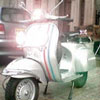Exotic carburation! I have to plead guilty to having always been a sucker for it. It may have begun when, as a teenager, I bought an Offenhauser 4 barrel manifold for my Studebaker from a local junkyard for $7. Things didn't change much when I moved on to Harleys. I vividly remember how cool those SU carbs looked on Pans and Shovels with the forward swept elbow.
Of course later when I got into drag racing Knuckleheads, dual carbs became more a necessity than a luxury. But when it came to a street bike, the traditional modification of the heads to hold two carbs held a drawback; that being in the form of a big lack of leg clearance.
Despite this leg clearance issue, the first dual Linkert setup I built consisted of one carb on each side. I used a pair of Linkerts (one on each side of engine going into a common manifold). I ran an M35 (1-1/8" venturi) as the primary carb, with an M74 (1-5/16" venturi) on the other side. I made up progressive linkage so that the M74 didn't start to open until the M35 was at half throttle, but they both reached WOT at the same time. It worked extremely well. Better gas mileage from doing most of your running on the small carb, but when you accelerated you could feel the second carb come in just like the secondaries on a car with a 4 barrel.

Dual Linkert - One Carb Out Each Side
The only downside was that the carbs I used had some wear so that too much air leaked past the throttle plates causing it to want to idle too high. I solved that by putting an auto advance distributor on it (the idle would slow when the weights came back retarding the spark). I think I could have solved the idle by using better carbs, or maybe by disabling the idle circuit on the second carb, but never tried it. Of course with the length of the Linkert, there still were leg clearance issues on the left side carb.
Perhaps a better solution is the method I used on my second foray into dual Linkerts. This manifold is based on a vintage "aftermarket" dual Linkert manifold that I have (and have seen other examples of). This vintage manifold is cast aluminum, and was designed to fit as a plumber manifold. My guess is that the aluminum would not have held up very well with brass seals and plumber nuts, but that is beside the point. The manifold is set up to take a pair of 3 bolt Linkerts, and has individual intake tracts; in other words the front carb feeds the front cylinder and the rear carb the rear cylinder. This coupled with the space limitations for such a design mean that the runners are extremely small, and thus extremely restrictive. The longer "tuned length probably would have given great throttle response and very low RPM performance, but I would bet that a stock 4 bolt Linkert would give better overall performance.

Vintage Dual 3 Bolt Linkert Manifold
Still, this vintage manifold is cool looking, and more importantly served as the inspiration for the next dual Linkert manifold project that I undertook. This next one was at the request of my friend Elmer. Elmer is world famous (seriously) for his Harley restorations, however, some time back he began to get a little weary of building the same bikes over and over. His solution was to start building a few "period correct" bobbers. Dual Linkerts were just the ticket!
 Dual Linkert Manifold - Plumber Style
Dual Linkert Manifold - Plumber Style
So I built another "prototype", and not just for looks either. I did flow bench testing to confirm that the manifold would be beneficial in the performance department, as well as the aesthetics side. I built it to use plumber fittings, at Elmer' insistence, so that it would be period correct for the original Holister event. It worked out very well, though the one thing I would change would be to cad plate the finished product rather than parkerize it as I did.
 Flow Testing Manifold
Flow Testing Manifold
This was all quite some time ago now (as evidenced by my old Superflow 110 in the picture - I upgraded to the SF600 about 7 years back) I have just now finally started on an aluminum version of this manifold set up for O-rings. Is the world ready for such a manifold, or am I the only sick one out here? I guess that remains to be seen!















































































